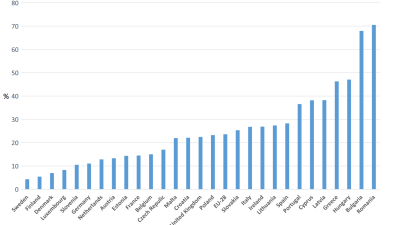The PSE income measure uses net income – that is, total income minus direct taxes (income tax, national insurance and council tax) and plus the value of any social security benefits received. This is the income that people have available to buy goods and services.
In addition, income after the deduction of housing costs (AHC), has been used (rather than before housing costs). This has been found to be more closely correlated with deprivation, is used in PSE analyses by income.
For households, the total net disposable income of all household members is included. To enable comparisons between households, total household income needs to be adjusted to reflect household composition and size. This is done using what’s called ‘equivalence scales’. These scales reflect the fact that a household of two adults needs more money than a one adult household to have the same standard of living but, because of economies of scale, they do not require twice the income. Similarly, households with children need more money than those without. But a child does not need as much as an adult.
Which equivalence scale is used and, in particular, what weight is given to children in the scale can make a difference to how different types of household appear to fare. The Office of National Statistics uses the OECD modified scale. Many have argued that these scales give insufficient weight to the costs of bringing up children and thereby produce lower estimates of poverty than a scale that more accurately reflects the costs of bringing up children. In addition, these scales do not allow for additional costs related to disability.
Therefore, the PSE research uses a scale based on the relatives implicit in the 2012 Minimum Income Standard.
PSE 2012 EQUIVALENCE SCALE (after housing costs)
Head of Household = 0.65
Partner = 0.35
Adult couple = 1.00
Each additional adult (anyone 16 and over) = 0.40
First child = 0.30
Each additional child = 0.25
Person with limiting longstanding disability = 0.30.



 PSE:UK is a major collaboration between the University of Bristol, Heriot-Watt University, The Open University, Queen's University Belfast, University of Glasgow and the University of York working with the National Centre for Social Research and the Northern Ireland Statistics and Research Agency. ESRC Grant RES-060-25-0052.
PSE:UK is a major collaboration between the University of Bristol, Heriot-Watt University, The Open University, Queen's University Belfast, University of Glasgow and the University of York working with the National Centre for Social Research and the Northern Ireland Statistics and Research Agency. ESRC Grant RES-060-25-0052.






